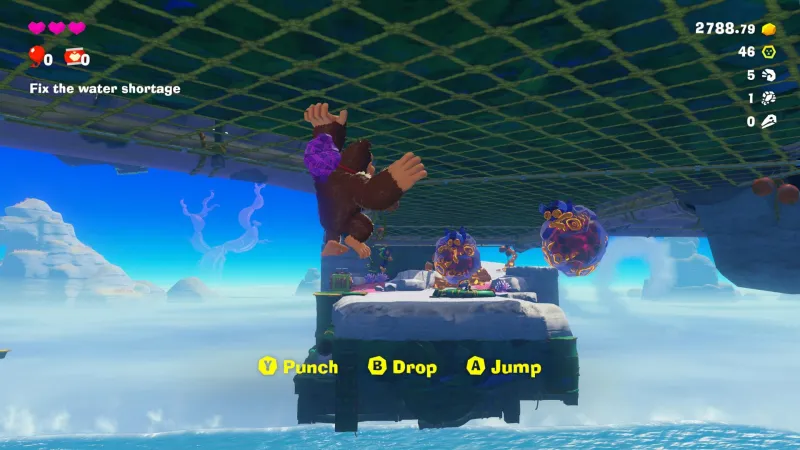

Our extra-large special edition is here. Subscribe today and receive the 25% longer issue at no extra cost!

I already got my hands on Donkey Kong Bananza in New York back on the same day it was announced. Though I came away impressed by the level of destruction and exploration packed into the various areas, the short amount of time I played at the Nintendo Switch 2 reveal event was not nearly enough to fully understand why I should be excited about this game outside of it being the first 3D Donkey Kong platformer in more than a quarter-century. Last week, I was given the opportunity to return to New York to play Donkey Kong Bananza. However, this time, I was given two full hours of hands-on time, and as a result, I emerged extremely excited to go bananas with DK later this month.
Like my April session, my hands-on time with Donkey Kong Bananza began in the Ingot Isles Mines, which serves as a tutorial location. Here, I relearn to smash terrain in all directions, slap the ground to pick up loot and locate secrets, and collect Banandium Gems and gold wherever I can find it. It also reminded me of the impressive level of destruction at play in Donkey Kong Bananza; I loved punching through every kind of terrain to forge new paths and unearth various collectibles. Plus, it's just so super satisfying to smash through walls with DK's fists. Though I'm afforded some exploration in the mines, I'm eager to see areas I haven't seen before, so I run towards the giant Banandium Gem at the end of the area and kickstart the main story.

Following that reintroduction to Bananza in the Ingot Isles Mines, my time with the game took me to three main areas: the Lagoon Layer, the Canyon Layer, and the Forest Layer. Lagoon Layer was comprised of SL100 and SL101 (numbers seemingly indicating the areas' progression within the game). It featured several pillars that I needed to destroy in order to unplug the water. With each destroyed pillar, the water level rose, opening access to new areas. This felt similar to Wet-Dry World in Super Mario 64, except it seems like the water only rises as you destroy more pillars.
While there, I also unlocked the first of DK's transformations: the Kong Bananza. This powered up his punching so he could not only destroy enemies and objects that normal Donkey Kong couldn't without the aid of harder terrain, but also destroy other objects with ease. Not only that, but each Bananza transformation has its own vocal track from Pauline. Bananza transformations only last a short amount of time, but they are incredibly powerful. This was particularly true as I moved on to the next area of my demo.

Following an extended period in the Lagoon Layer, I explored the Canyon Layer (SL300), which allowed me to experiment with different terrain and offered a bit more vertical and underground exploration. It was here that the destruction really started to sing as I dug deep into the canyon in search of collectibles. Aided by the Kong Bananza's powerful punch, I started racking up Banadium Gems from across the map. As you hit certain milestones in your Banandium collection, you earn skill points, which can be used for upgrades to DK's health, punching power, and collection radius; they can also grant new abilities to Donkey Kong, like a skill where he can use terrain he ripped from the ground to surf across water or the ability to slam a chunk he's carrying into the ground after jumping. You can opt to use skill points to upgrade your Bananza transformations (more on that later).
My time in the Canyon Layer culminated in a boss battle against Grumpy Kong. This employee of the dastardly corporation VoidCo creates a multi-terrain golem with a giant club made of rock, which he violently swings. After absorbing a few hits, I scurried to grab some apples to restore DK's health. I was tempted to use the Kong Bananza, but I wanted to do this as standard DK. I punch through a layer of softer terrain before realizing I could rip rocks out of the golem's body and use them as a way to break the harder material making up the body of the monster. In a "eureka!" moment, I decided to rip chunks out of Grumpy Kong's club, which, after a few rounds, reduced it to a near-harmless nub. After eating away much of its armor, its vulnerability point was exposed on the top of its head, and DK was free to beat Grumpy Kong into submission and defeat the boss.

After moving to the final area of my session, the Forest Layer (SL-600), I realized that the easy exploration I experienced in the previous layers would not last. Poisonous lakes, thorny plants, and more aggressive enemies littered the Forest Layer, making for plenty of challenge. Thankfully, in this final session, I could utilize the Ostrich Bananza, which allows DK to transform into a bird-like hybrid and glide for a limited time. I was surprised by how short his flight is, but you can upgrade that using skill points. During this section of my demo, I used a skill point to unlock a move where DK can drop egg bombs while in his Ostrich Bananza form.
During my hands-on time, I completed various Challenge Courses and Battle Courses, two types of sectioned-off rooms you discover throughout the explorable areas of Donkey Kong Bananza. These curated challenges offered puzzles, platforming obstacle courses, timed combat scenarios, and even barrel-blasting exploration. Whether I was precariously navigating around thorny vines, avoiding moving walls while hanging from a grate and climbing, or defeating a group of enemies before time expired, I eagerly looked forward to each new challenge room. And since they offer optional Banandium Gems for completing optional tasks or finding hidden areas, it seems like you'll have plenty of reason to spend extra time or replay these fun rooms.

I was perhaps most eager to play through a 2D sequence as shown in the Donkey Kong Bananza Nintendo Direct a couple of weeks ago. These are mixed in with the Challenge Courses, and the one I stumbled upon threw a labyrinthine barrel course at me. This felt like a superb throwback to the Donkey Kong Country stages we all remember, but DK retains his complete moveset, including Bananza transformations. My primary concern with these stages – that, like other 3D platformers that incorporate 2D sequences, the physics wouldn't feel quite right in 2D – was soothed when I had the chance to run and jump from this perspective. I'm happy to report that it felt terrific in 2D, even given the limited time I had and despite the platforming I was doing not being particularly challenging.
The only negative I can really say from my hands-on session is that the framerate really struggled to keep up with the action unfolding on screen on a fairly regular basis. While it's nowhere near as bad as some other games we've seen on the original Nintendo Switch, it's slightly concerning that the second major first-party title for the company's new, more powerful hardware can't consistently perform well. However, it is entirely possible that the build I played isn't fully optimized the way the launch version will be.

Before concluding my gameplay session, I participated in a brief co-op play session. The second player controls Pauline's vocal blasts, which can emulate different terrain, smash through walls, and even defeat enemies. You can control Pauline's crosshairs using the mouse mode of the Joy-Con 2, motion controls, or traditional gamepad controls. It's a more active co-op experience than either Super Mario Galaxy or Super Mario Odyssey. However, it still feels more like a fun way to incorporate a less-experienced player into the fun rather than a destination mode.
Midway through my demo, I felt a strong sense of excitement overtake my mind. I was still focusing on the gameplay, but I was more looking forward to the long nights I will inevitably spend exploring the many layers and biomes with Donkey Kong and Pauline when Donkey Kong Bananza arrives on Nintendo Switch 2 on July 17.

Explore your favorite games in premium print format, delivered to your door.